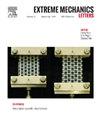Modeling and control of coupled soft viscoelastic actuators based on sparse identification method
IF 4.5
3区 工程技术
Q2 MATERIALS SCIENCE, MULTIDISCIPLINARY
引用次数: 0
Abstract
Dielectric elastomer actuators (DEAs) are extensively employed as artificial muscles in bioinspired soft robotics due to their large voltage-induced deformations and muscle-like characteristics. Achieving complex, multiple degree of freedom(DOF) motions often requires coupling multiple DEAs. However, modeling and controlling coupled DEAs pose significant challenges due to their inherently nonlinear response, driven by factors such as rate-dependent viscoelasticity, design irregularities, and complex interactions among adjacent actuators. This study presents a comprehensive framework for the modeling and control of multiple coupled DEAs, leveraging a sparse identification approach to derive explicit governing equations that effectively describe the viscoelastic and coupling effects from experimental data. Using these identified equations, we design a model predictive controller (MPC) that enables precise trajectory tracking across a range of motion profiles. The proposed framework is validated through tracking experiments on DEAs with two DOFs, demonstrating its effectiveness and robustness. This approach offers a novel pathway for uncovering the underlying physics of coupled DEAs, with the potential to enhance the functional capabilities of DEA-driven soft robotic systems.
基于稀疏辨识方法的耦合软粘弹性作动器建模与控制
介电弹性体致动器(dea)由于具有较大的电压诱导变形和类似肌肉的特性,在仿生软机器人中被广泛用作人造肌肉。实现复杂的多自由度(DOF)运动通常需要耦合多个dea。然而,耦合dea的建模和控制面临着巨大的挑战,因为它们固有的非线性响应,受速率相关的粘弹性、设计不规则性和相邻执行器之间复杂的相互作用等因素的驱动。本研究为多个耦合dea的建模和控制提供了一个全面的框架,利用稀疏识别方法从实验数据中推导出有效描述粘弹性和耦合效应的显式控制方程。利用这些确定的方程,我们设计了一个模型预测控制器(MPC),可以在一系列运动剖面中进行精确的轨迹跟踪。通过双自由度dea跟踪实验验证了该框架的有效性和鲁棒性。这种方法为揭示耦合dea的潜在物理特性提供了一种新的途径,具有增强dea驱动的软机器人系统功能的潜力。
本文章由计算机程序翻译,如有差异,请以英文原文为准。
求助全文
约1分钟内获得全文
求助全文
来源期刊

Extreme Mechanics Letters
Engineering-Mechanics of Materials
CiteScore
9.20
自引率
4.30%
发文量
179
审稿时长
45 days
期刊介绍:
Extreme Mechanics Letters (EML) enables rapid communication of research that highlights the role of mechanics in multi-disciplinary areas across materials science, physics, chemistry, biology, medicine and engineering. Emphasis is on the impact, depth and originality of new concepts, methods and observations at the forefront of applied sciences.
 求助内容:
求助内容: 应助结果提醒方式:
应助结果提醒方式:


